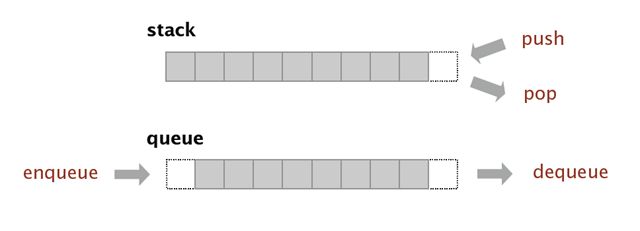数据结构之栈和队列
1.基本概念
栈 (Stack)是一种后进先出(last in first off,LIFO)的数据结构,而队列(Queue)则是一种先进先出 (fisrt in first out,FIFO)的结构,如下图:
2.链表实现的栈
/**
* @Title: LinkedStack.java
* @Package io.shaoshuai.datastructure
* @Description: TODO
* @author 帅
* @date 2015年5月15日 下午6:27:32
* @version V1.0
*/
package io.shaoshuai.datastructure;
import java.util.Iterator;
/**
* @ClassName: LinkedStack
* @Description: TODO
* @author 帅
* @date 2015年5月15日 下午6:27:32
*
*/
public class LinkedStack implements Iterable{
/**
* 往栈中添加一个新的元素
* @param item
*/
public void push(E item){
Node oldFirst = first;
first = new Node(item);
first.next = oldFirst;
size ++;
}
/**
* 移除并返回最近添加的元素
* @return
*/
public E pop(){
E item = first.item;
first = first.next;
size --;
return item;
}
/**
* 栈是否为空
* @return
*/
public boolean isEmpty(){
return size == 0;
}
/**
* 栈中元素的个数
* @return
*/
public int size(){
return size;
}
private Node first;
private int size;
/**
* 单向链表数据结构
* @ClassName: Node
* @Description: TODO
* @author 帅
* @date 2015年5月18日 上午12:19:53
*
* @param
*/
private static class Node {
public E item;
public Node next;
public Node(E item) {
this.item = item;
}
}
/**
* 栈的迭代器
*/
@Override
public Iterator iterator() {
return new Iterator(){
private Node current = first;
@Override
public boolean hasNext() {
return current != null;
}
@Override
public E next() {
E item = current.item;
current = current.next;
return item;
}
@Override
public void remove() {
first = first.next;
size --;
}
};
}
public static void main(String[] args) {
LinkedStack linkedStack = new LinkedStack();
linkedStack.push(new String("1"));
linkedStack.push(new String("2"));
linkedStack.push(new String("3"));
linkedStack.push(new String("4"));
linkedStack.push(new String("5"));
linkedStack.push(new String("6"));
System.out.println(linkedStack.size());
System.out.println(linkedStack.isEmpty());
System.out.println(linkedStack.pop());
System.out.println(linkedStack.size());
}
}
/**
* @Title: ArrayStack.java
* @Package io.shaoshuai.datastructure
* @Description: TODO
* @author 帅
* @date 2015年5月15日 下午7:21:39
* @version V1.0
*/
package io.shaoshuai.datastructure;
/**
* @ClassName: ArrayStack
* @Description: TODO
* @author 帅
* @date 2015年5月15日 下午7:21:39
*
*/
public class ArrayStack {
private static final int DEFAULT_CAPACITY = 1<<4;
private E[] elements;
private int size;
@SuppressWarnings("unchecked")
public ArrayStack() {
elements = (E[]) new Object[DEFAULT_CAPACITY];
}
@SuppressWarnings("unchecked")
public ArrayStack(int capacity) {
elements = (E[]) new Object[capacity];
}
/**
* 往栈中添加一个新的元素
* @param item
*/
public void push(E item){
if(size == elements.length) {
resize(elements.length * 2);
}
elements[size++] = item;
}
/**
* 移除并返回最近添加的元素
* @return
*/
public E pop(){
E element = elements[--size];
//elements[size] = default(E);
if(size > 0 && size == elements.length/4) {
resize(elements.length/2);
}
return element;
}
/**
* 栈是否为空
* @return
*/
public boolean isEmpty(){
return size == 0;
}
/**
* 栈中元素的个数
* @return
*/
public int size(){
return size;
}
@SuppressWarnings("unchecked")
private void resize(int capacity){
E[] tmp = (E[]) new Object[capacity];
for (int i = 0; i < capacity; i++) {
tmp[i]=elements[i];
}
elements = tmp;
}
public static void main(String[] args) {
ArrayStack stack = new ArrayStack();
stack.push(new String("1"));
stack.push(new String("2"));
stack.push(new String("3"));
stack.push(new String("4"));
stack.push(new String("5"));
stack.push(new String("6"));
System.out.println(stack.size());
System.out.println(stack.isEmpty());
System.out.println(stack.pop());
System.out.println(stack.size());
}
}
4.链表实现的队列
/**
* @Title: LinkedQueue.java
* @Package io.shaoshuai.datastructure
* @Description: TODO
* @author 帅
* @date 2015年5月15日 下午3:08:43
* @version V1.0
*/
package io.shaoshuai.datastructure;
import java.util.Iterator;
/**
* @ClassName: LinkedQueue
* @Description: TODO
* @author 帅
* @date 2015年5月15日 下午3:08:43
*
*/
public class LinkedQueue implements Iterable{
private Node first;
private Node last;
private int size;
public LinkedQueue(){
}
/**
* 往队列中添加一个新的元素
* @param item
*/
public void enLinkedQueue(E item){
Node oldLast = last;
last = new Node(item);
if(isEmpty()) {
first = last;
}else {
oldLast.next = last;
}
size++;
}
/**
* 移除队列中最早添加的元素
* @return
*/
public E deLinkedQueue(){
E item = first.item;
first = first.next;
size --;
if(isEmpty()) {
last = null;
}
return item;
}
/**
* 队列是否为空
* @return
*/
public boolean isEmpty(){
return size == 0;
}
/**
* 队列中元素的个数
* @return
*/
public int size(){
return size;
}
@Override
public Iterator iterator() {
return null;
}
private static class Node {
private E item;
private Node next;
public Node(E item) {
this.item = item;
}
}
public static void main(String[] args) {
LinkedQueue linkedQueue = new LinkedQueue();
linkedQueue.enLinkedQueue("1");
linkedQueue.enLinkedQueue("2");
linkedQueue.enLinkedQueue("3");
linkedQueue.enLinkedQueue("4");
linkedQueue.enLinkedQueue("5");
System.out.println("size:" + linkedQueue.size());
System.out.println(linkedQueue.deLinkedQueue());
System.out.println(linkedQueue.deLinkedQueue());
System.out.println("size:" + linkedQueue.size());
}
}
5.数组实现的队列
/**
* @Title: ArrayQueue.java
* @Package io.shaoshuai.datastructure
* @Description: TODO
* @author 帅
* @date 2015年5月15日 下午10:51:59
* @version V1.0
*/
package io.shaoshuai.datastructure;
import java.util.Iterator;
/**
* @ClassName: ArrayQueue
* @Description: TODO
* @author 帅
* @date 2015年5月15日 下午10:51:59
*
*/
public class ArrayQueue implements Iterable{
private static final int DEFAULT_CAPACITY = 1<<4;
private E[] elements;
private int head;
private int tail;
private int size;
@SuppressWarnings("unchecked")
public ArrayQueue() {
elements = (E[]) new Object[DEFAULT_CAPACITY];
}
@SuppressWarnings("unchecked")
public ArrayQueue(int capacity) {
elements = (E[]) new Object[capacity];
}
/**
* 往队列中添加一个新的元素
* @param item
*/
public void enqueue(E element){
if((head - tail + 1) == elements.length) {
resize(elements.length * 2);
}
elements[tail] = element;
tail = (++tail == elements.length ? 0 : tail);
size ++;
}
/**
* 移除队列中最早添加的元素
* @return
*/
public E dequeue(){
E element = elements[head];
if(head > 0 && (tail - head + 1) == elements.length/4){
resize(elements.length/2);
}
head = (++head == elements.length ? 0 : head);
size--;
return element;
}
/**
* 队列是否为空
* @return
*/
public boolean isEmpty(){
return size == 0;
}
/**
* 队列中元素的个数
* @return
*/
public int size(){
return size;
}
@SuppressWarnings("unchecked")
public void resize(int capacity){
E[] tmp = (E[]) new Object[capacity];
for(int i=0;i iterator() {
return null;
}
public static void main(String[] args) {
ArrayQueue queue = new ArrayQueue();
queue.enqueue("1");
queue.enqueue("2");
queue.enqueue("3");
queue.enqueue("4");
queue.enqueue("5");
System.out.println("size:" + queue.size());
System.out.println(queue.dequeue());
System.out.println(queue.dequeue());
System.out.println(queue.dequeue());
System.out.println("size:" + queue.size());
}
}
6.Stack和Queue的应用
未完待续
